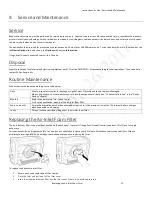
Instructions for Use | Cleaning and Disinfection
External Active Exhalation Valve Cleaning and Disinfection
74
To disinfect the valve:
1.
Disassemble the valve, discarding
the silicon diaphragm according to your local regulations on discarding biohazardous waste.
Then
proceed to clean and dry the valve according to the instructions in the previous section, “Cleaning the External Active Exhalation Valve.”
2.
Read and follow the manufacturer’s instructions on how to prepare, activate, use, and dispose of the Cidex solution. Follow all safety
precautions.
3.
Submerge the clean and dry valve in Cidex solution. Agitate the parts to ensure all internal and external surfaces are saturated with the
solution. Soak the valve in Cidex for 45 minutes at 20°C.
4.
Remove the valve from the solution and pour excess cleaning agent from the valve.
5.
Rinse thoroughly with clear water.
6.
Allow the valve to dry entirely.
7.
Examine the valve. Replace any part that is
damaged (visible cracks, distorted parts
, or altered color
)
.
8.
Insert a new diaphragm as shown in the illustration. Ensure you have positioned the diaphragm correctly.
9.
Reassemble the valve and replace it as shown in
Figures 4 and 5
in the previous section.
Sterilizing the External Active Exhalation Valve
You can sterilize the external active exhalation valve using a hydrogen peroxide gas plasma sterilizer, such as Sterrad®.
Requirements
: Replacement
silicon
diaphragm
To sterilize the valve:
1.
Disassemble the valve, discarding
the silicon diaphragm according to your local regulations on discarding biohazardous waste.
Then
proceed to clean and dry the valve according to the instructions in the previous section, “Cleaning the External Active Exhalation Valve.”
2.
Read and follow the instructions of your sterilization device. Follow all safety precautions.
1.
Allow the valve to cool and dry entirely in a clean and dry environment.
Caution: Allow any liquid to evaporate entirely before reconnecting the valve
.
2.
Examine the valve. Replace any part that is damaged (visible cracks, dis
torted parts, or altered color
)
.
3.
Insert a new diaphragm as shown in the illustration. Ensure you have positioned the diaphragm correctly.
4.
Reassemble the valve and replace it as shown in
Figures 4 and 5
in the previous section.
















































